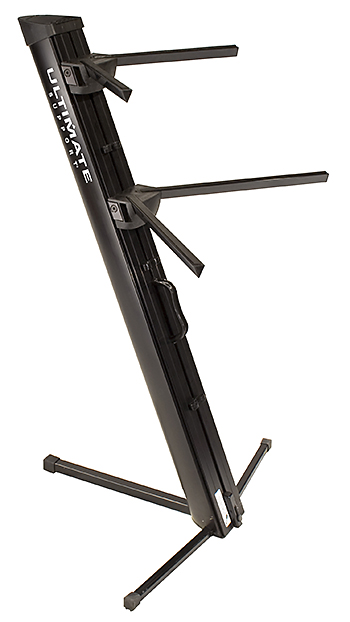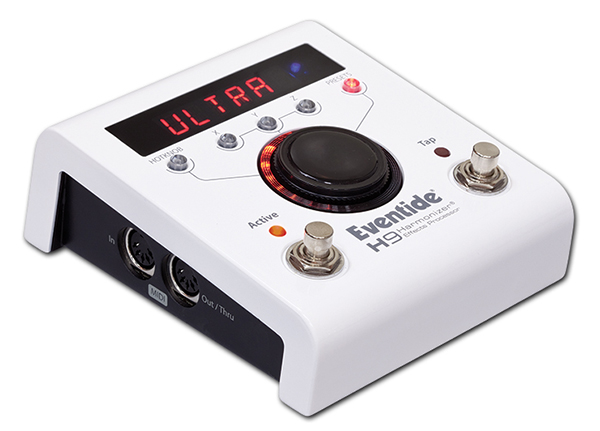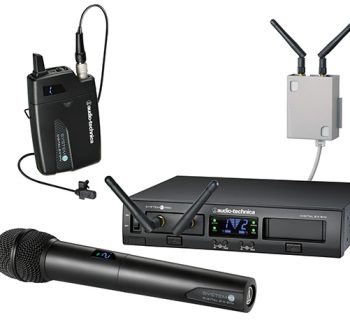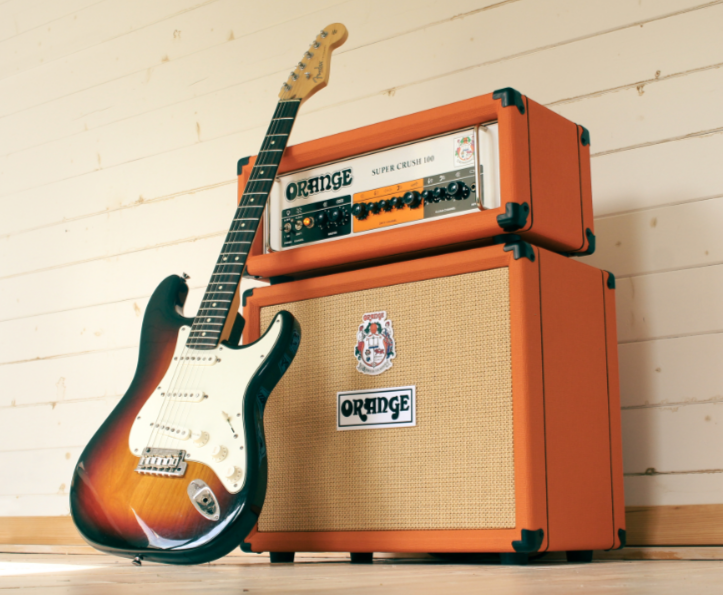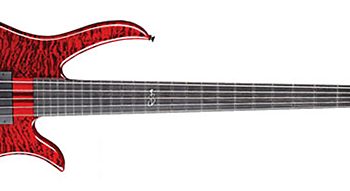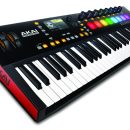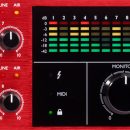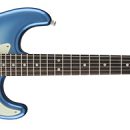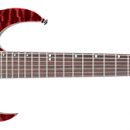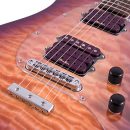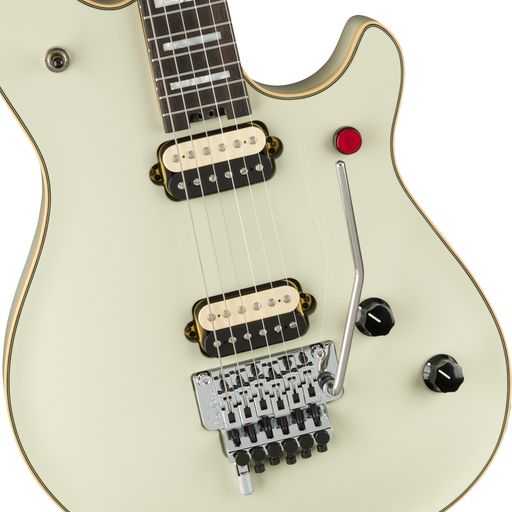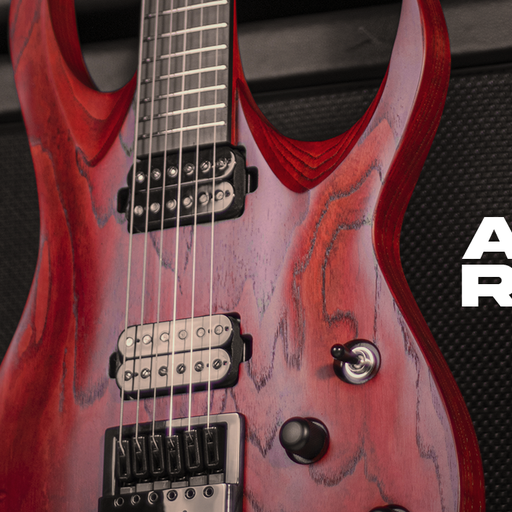
Eventide has a long-standing reputation for producing high quality and unique sounding effects. Their H9 Harmonizer multi-effects pedal upholds that stellar reputation and delivers all of the features of their excellent Factor series pedals and then takes things to another level.
We put the Eventide H9 through its paces and bent sound in ways only Eventide can deliver. If you are a technologically savvy musician who craves advanced effects features with unsurpassed usability—and you can tolerate a reasonable learning curve, this is one cool pedal you’ll want to add to your rig.
| Category | Value | Rating |
| Features | 20% | |
| Usability | 25% | |
| Sound | 25% | |
| Documentation & Support | 10% | |
| Price | 20% | |
|
|
||
| OVERALL RATING = 3.6 Stars, which earns it a WIHO Award!3.6 stars or better: Outstanding, WIHO Award 3 stars or better: Worth considering 2 stars or better: Suited to specific needs 1 star or less: Not recommended |
||
Features
The Eventide H9 is clad in a white metal housing, and the Harmonizer Multi Effects version (there is a more economical Core version) comes loaded with numerous algorithms from the four preceding Factor pedals. Those algorithms (think effect blocks) include: Tape Echo (Delay, saturation wow and flutter controls) and Vintage Delay (offering delay, modulation and filter controls) from the Eventide TimeFactor, Chorus and Tremolo from ModFactor, H910/H949 (pitch and delay) from PitchFactor, Shimmer (allowing for pitch, delay and reverb functions) and Hall (includes reverb, some modulation and eq) from Space, and, exclusive to the H9, Ultratap, for when you just must have 64 delay taps at your beck and call. Yes… 64. Wow.
Algorithms are a one-at-a-time affair, meaning that only one can be loaded (running) at a time. So although some of them contain multiple effects like pitch and delay in combination, this isn’t a true multi-effects processor by classical definition.
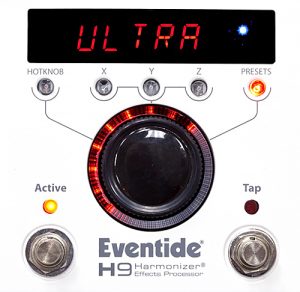 The H9 Core pedal only includes the H910/H949 algorithm to start.
The H9 Core pedal only includes the H910/H949 algorithm to start.
More algorithms for each pedal may be purchased online and are downloadable via a free app that syncs via Bluetooth between your iOS device (version 5.0 or higher, so our first-generation iPad now has a legitimate use again) and the H9 pedal. The free app, named H9 Control, serves to program, update, arrange presets, and provide real-time control over the H9.
The Eventide algorithm scheme is a block of predetermined parameters for a specific effect or effects such as pitch plus delay, or delay plus modulation. These parameters are blocked together and called an algorithm.
The H9 has two footswitches labeled Active and Tap, and corresponding red indicator lights. There are three buttons labeled X, Y, and Z, which are used to access algorithm parameters. In the center of the pedal there is an encoder knob (which also depresses as a switch) that has many functions, the most important being parameter value changes. The very top of the pedal has a six-character LED display with four indicator lights that show Bluetooth and signal level values. There is also a Presets button that both changes presets as well as operating mode for the pedal.
A Kill Dry setting is available for guitarists using the H9 in a parallel effects loop (to avoid phasing problems) — an essential detail missing in many other supposedly premium digital effects pedals destined for use in a loop rather than in front of an amp.
No pedal of such technical wizardry would be complete without a healthy assortment of I/O. ¼-inch stereo ins and outs complimented by MIDI In/Out as well as USB (for connecting to your computer) are all provided. There is also a ¼-inch expression pedal jack, and the power supply is 9V, 500ma, center-positive (wall wart type, included).

What’s missing? We really wished this pedal had digital I/O. Given the high-quality A/D/A conversions going on inside, and the full stereo in/out capability, it would be great to put the H9 to use in our studio for more than just guitar work.
Usability
As you might expect with such a complex signal processor (it sounds almost belittling to call the Eventide H9 a pedal), there is a learning curve to this thing. To start, other than the obvious Active and Tap footswitches, everything about interacting with this pedal is different. It doesn’t even resemble our other Eventide Factor pedals.
We found the iOS-based editor to be thoughtfully laid out and extremely useful, with a fun GUI that made great use of our first-generation iPad. The presets list and method of updating the pedal had room for improvement, though, as they weren’t quite as refined as the interface through which we could manipulate the parameters of our effects.
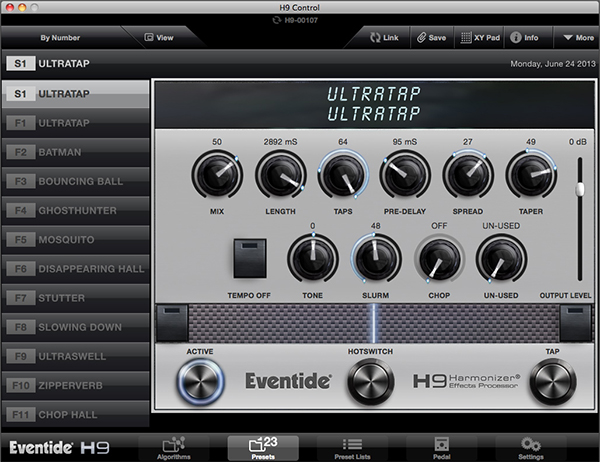
The pedal had no blank presets, so any changes we made required writing over factory settings. The basic process: choose an existing preset utilizing our desired effect algorithm, modify the preset to taste, and finally save it as a new preset. Using this methodology, we were able to create and organize a list of our new user presets (in the app) and export them to the pedal. Likewise, we could save the H9’s list of presets back to the app. For players in multiple bands and playing situations, the relationship between pedal and iPad is immensely useful. We were able to make presets lists for different sets and instantly download the right effects for the gig into the pedal. Because the connectivity happens wirelessly over Bluetooth, it’s simple enough to throw your iPad in a gig bag and manage set lists at the gig.
Another very thoughtful function (and one we’ve never seen before) was being able to define how many presets the pedal holds (up to 99 presets are available). If we only needed two presets for our blues rock gig, for example, the pedal would simply have presets 1 and 2 available to us, until we loaded larger effects lists into the pedal from the app. This came in very handy when we used the pedal as a dedicated special effects devices in our rig as opposed to meat and potatoes delays and choruses, where we’d load it up with numerous effects presets.
The X, Y and Z buttons came with pre-determined function in each algorithm that we were able to re-assign as we saw fit. If the X button was assigned to control the wet/dry level of a particular effect, depressing the X button and turning the encoder accurately controlled this function. Depressing the encoder allowed for precise tuning of the parameters. This was simple enough.
However, having left no stone unturned, Eventide created a Master mode, accessible by holding the X, Y or Z button down (this is where things get trickier than your average pedal). Once the pedal is in Master mode, every available parameter in the algorithm becomes controllable by continuing to depress that button. If we held down the Z button, it entered Master mode while the X and Y button still controlled only their assigned parameters. The Hotknob button was effectively an expression pedal when used with the encoder, allowing grouping of X, Y and Z or any combination thereof.
Scrolling through presets had two different modes. When the Preset button was illuminated, moving the encoder instantly changed presets. If the Preset button was not lit, stepping on the TAP button quickly (as to not engage the tap tempo feature) queued presets one press at a time sequentially. Stepping on the Encoder toggled direction between ascending and descending through the presets. This came in handy the times we overshot the preset we were looking for.
Pressing both footswitches at the same time enabled the onboard tuner. This is a feat not left to your… feet, as the footswitches are too far apart for easy access. We think it’s more useful if you just brought this pedal to a studio session as opposed to using the pedal in a live situation. As to performance, the built in tuner was both fast and accurate.
The H9 was intelligent enough to know when it was being used in mono or stereo operation, and setting levels was a breeze. It was easy to set the pedal for true bypass operation, DSP bypass, and DSP plus FX bypass, which allowed the tails of the effects to spill over after the Active button was disengaged.
Real-time controls and presets selection are controllable via MIDI, so players with appropriate MIDI foot controllers can take as much control here as they would with any rack-mounted multi-effects processor. We had no trouble figuring out basic control operations with both an RJM Music Technology MasterMind GT as well as a Voodoo Lab Ground Control Pro.
However, the H9 pedal is easiest to program (and in some instances, use) with the iOS app. The pedal is just too comprehensive of a product to be set up and used solely by hand. If you don’t have access to an iPad, you’re probably best served by one of the Eventide Factor effects pedals (or two or three of them), which are more easily manipulated from their control panels. Once we got the pedal programmed, only then did we use the pedal as a traditional stomp box. We still found ourselves repeatedly going back to the app to make changes, even after our list was made and transferred from the app to the pedal. It was just easier and faster.
The Eventide H9 algorithms are shareable between multiple H9 units. For example, if you wanted one H9 in your effects loop and one to feed the front of the amp, Eventide allows sharing of algorithms on one account for up to five devices, so you only have to purchase the algorithm once. So yes, you could purchase one fully-loaded H9 and one less costly H9 Core and share all of your algorithms across both pedals.
Tracking was spot on, but we did feel a slight latency in the sound. We could not find exact figures from Eventide, but we fairly estimate the latency to be between 2 and 5ms, roughly equivalent to standing an additional five feet away from your amp. We also noticed that it took nearly a full second to load some of the algorithms.
Sound
The sound of the H9 is, in no uncertain terms, amazing. Once we familiarized ourselves with the pedal, we played through a few of the algorithms with the H9 in our effects loop of our Marshall DSL. The five different chorus algorithms (liquid, organic, shimmer, classic and phase xo) were easily as organic and lush as the best modulation pedals from your favorite boutique builders. Typical knobs on the H9 control app controlled depth, modulation rate, speed etc. With all five algorithms, Eventide had us covered for every conceivable chorus we thought of. We felt in terms of dimension and quality, the Eventide offered a cut above, never sounding generic and always putting its own recognizable sonic stamp. This set the tone (pun intended) for the rest of our sound testing.
We couldn't in good conscious review an Eventide product with its legendary pitch shaping capabilities and not thoroughly critique it. A close friend of ours stated after finding out we were reviewing the H9, “Way back in the early days of digital effects, when you walked in and saw an Eventide, you just know something awesome was going to happen.” This has not changed. The H910/H949 and Crystals algorithms are simply perfect, instantly distinct, and recognizably Eventide. The preset, “Ballerina,” quickly brought our minds and ears back to 1990s Steve Vai groundbreaking release, Passion and Warfare. There was no question to us that the H9 was fully capable of reproducing all of the pitch shifting duties heard on that recording and then some.
Back to the pitch shifting sounds. There were two delays and reverbs on tap to mix in with the original pitch, with healthy controls for regeneration—to the point of endless oscillation if you so choose. Our options for creating new and unique sounds were limitless. However, we wanted intelligent pitch shifting. After all, this was an Eventide. This required a download—courtesy of our free algorithm voucher—of the Quadravox algorithm. We were completely satisfied, and if we had to buy it at $20 dollars retail, it was more than worth the money. Intelligent pitch shifting with lush and interesting presets were what we hoped to get from the H9, and this algorithm delivered perfectly.
The Tape Echo and Vintage Delay algorithms both performed well. The tails had plenty of color and character and never sounded generic or sterile. Many of the presets using these algorithms were very musical and could have easily inspired our songwriting. Often, the H9 made us want to stop reviewing and start writing! The tape echo included Wow and Flutter controls while the vintage delay included light modulation. These algorithms were very musical and a nice addition to the base package if you buy the H9 Core.
Next up were the shimmer and hall algorithms, taken from the equally awesome Eventide Space pedal. This is your sci-fi, U2-on-steroids, ethereal effects algorithm, and it creates awesome pitch shifting effects with funky decays. The reverb tails, when dialed in a certain way, sounded like dark pad patches off of a keyboard. The hall reverb had some modulation control, which gave the reverb more depth and character than any typical reverb effect.
The final algorithm we have to talk about is all new and exclusive to the Eventide H9: Ultra Tap. The ultra tap offered up 64 taps and a full four seconds of delay. Slurm and Chop controls annihilated our original notes and took them into uncharted musical bliss.
A recurring theme with the H9 was that although it seemed to be able to twist and bend what we played far beyond what we thought we could ever use, it always came out musical. So whether you need bread-and-butter time based effects, harmonization, or ethereal stuff, the Eventide H9 can easily be your one go-to effects processor.
Documentation and Product Support
The Eventide H9 came with both a 49-page comprehensive user’s guide for operation and an algorithms guide detailing every parameter for every algorithm.
An email to Eventide with a tech support question was answered in hours, and a phone call was answered in under five minutes. We couldn't have asked for better support. And if that’s not enough, there is also a support forum on the website where an Eventide tech agent actively contributes. From what we can tell, they’re listening.
The standard Eventide warranty covers one year parts and labor.
Price
The Eventide H9 Harmonizer Multi Effects Pedal (MSRP $579) sells for approximately $500. It’s not cheap, but it’s easily worth the money if sound quality is your top criteria. Additional algorithms are only $20 apiece, available for purchase via the H9 Control app.
If you have only specific algorithm requirements, you may be well served by the H9 Core (MSRP $499), which sells for just under $400 street.
Included in the box are a wall-wart power supply, USB cable, the manual and algorithm guide, an Eventide sticker, an Eventide guitar pick, and a velour bag—for the one player who won’t be sticking this on a shelf in the rack or on a nicely tricked out pedalboard.
Contact Information
Eventide
www.eventide.com
| Evaluation Short-List |
| • TC Electronic Nova System • Line 6 M9 • Electro-Harmonix Epitome |


